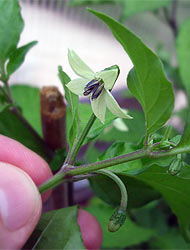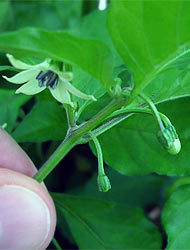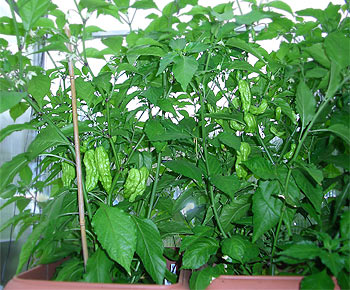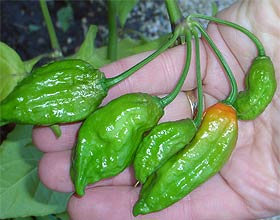|
As part of an extensive extensive study, Dr. Paul Bosland and the NMSU Chile Pepper Institute examined a chile pepper variety named Bhut Jolokia (see detailed report here).
Directly from India, equally fiery chiles reached us under the name Bih Jolokia. And finally, a variety surfaced from the UK, named Naga Morich (info).
Seeds for test cultivation were available for all three flavors of this hot pepper, which we grew in 2007. Here are the results.
Please note that any observations and conclusions are highly subjective, as they are based on our small-scale test with just a few plants. Scientific data would require a larger number of test plants and preferably a test running several years. Nevertheless we thought you’d find our findings interesting.
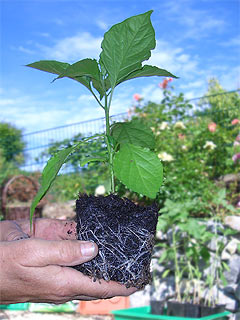
|

Summer weather in Germany is always hard to predict – to stay independent, we conducted our little experiment in the Pepperworld test greenhouse, using automatic watering.
The seeds for all three peppers were started mid March. All three germinated well and produced healthy plants with leaves typical for Capsicum chinense, and lots of roots.
Early June, it was about time for the Bhut Jolokia plant to the left as well as for the other ones to be transplanted to larger containers. All three received a long-term fertilizer with their soil.
 Greenhouse tenants Greenhouse tenants
|
|

Once the fruits have reached about their final size, they start changing colors, going through a darker green, followed by orange, and eventually – surprise! – by a deep red. The final red stage was interesting for us, as all pictures submitted by the CPI as well as Indian sources showed Bhuts, Bihs and Nagas with an orange color, i.e. not fully mature (this includes the pictures that made worldwide news after the Guinness World Records entry became public.) Frontal Agritech’s specs list “red” as mature color, though. And here it is.

End of October – “Judgment Day” for our three test peppers. To take a photo, we took one plant of each outside. From left to right, that’s Bhut Jolokia, Bih Jolokia, and Naga Morich. All three plants grew to about the same size and shape, including comparable branching. While Bhut and Bih produced fruit in comparable size and count (Bih slightly smaller ones), Morich’s pods were significantly smaller, but there were more of them, so that the harvest in weight turned out to be about the same for al three peppers.
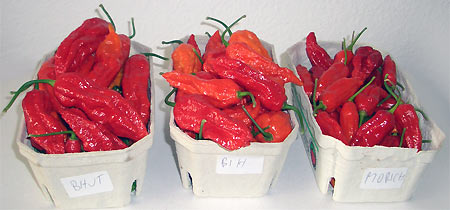
So here’s the harvest for further examination…
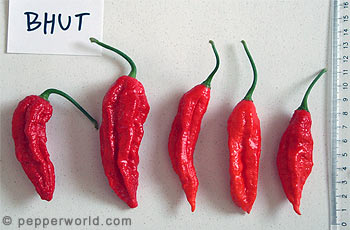
All three are showing extreme variation in shape.
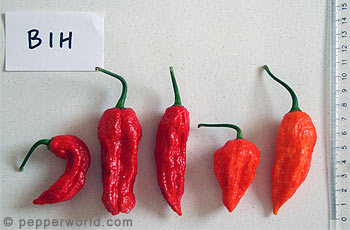
While some chile varieties like Jalapeno or Orange Habanero produce mostly uniformly sized and shaped pods, the various Indian Naga variants developed all kinds of shapes on the same plant, even off the same node. Some are slim, others are roundish with wide shoulders. Some have a round tip, while others are tapered, mostly combined with a slim shoulder.

Therefore, determining the variety based on the shape of the fruits is almost impossible. Only the bubbly, uneven surface of the pods seems to be characteristic for this kind of chile.
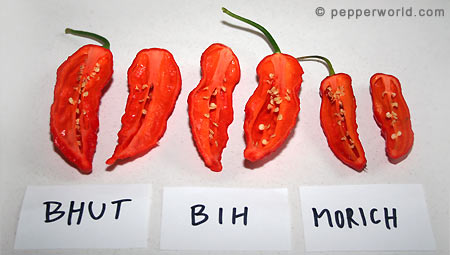
Now for the “inner values”. The structure – three, sometimes four chambers, thin divider walls – seems to be almost identical on all three peppers. They also have in common that there’s not too many seeds inside, often less then 20 per pod. A tedious business for seed producers.
Regarding heat, we did no HPLC testing and just taste-tested all three variants. The testers agreed that all of them were extremely fiery, much more than any vaariety they had before. In this heat range, a level of saturation is reached, though – very much like you won’t feel much difference if you burn your finger over a candle or a propane burner.
Conclusion
So that’s our little comparison test. While our findings are in sync with those by various pepper friends of ours (see here, for example), other chile gardeners results may differ. It looks very much though as if at least Bhut Jolokia and Bih Jolokia (at least from the seeds we received) are indeed very similarly, if not the same. Also the dried Bhut pods we received from the Chile Pepper Institute and the Bih pods we got directly from Assam, India look, taste quite and burn quite similar. Slight variations were observed with Naga Morich, with many fruits per node occuring more frequently, as well as smaller pods and a higher fruit count, compared to Bih and Bhut Jolokia. A Morich plant from the previous year, grown from the same Chileman seedpack, was even more prolific in its 2nd year (see updated Saga Jolokia report).

One thing all three have in common for sure: As evidenced by this picture, these peppers are not just extremely hot, they’re all beautiful members of the huge capsicum family.
Further Information
All photos Copyright © Harald Zoschke, www.pepperworld.com
|







 Greenhouse tenants
Greenhouse tenants